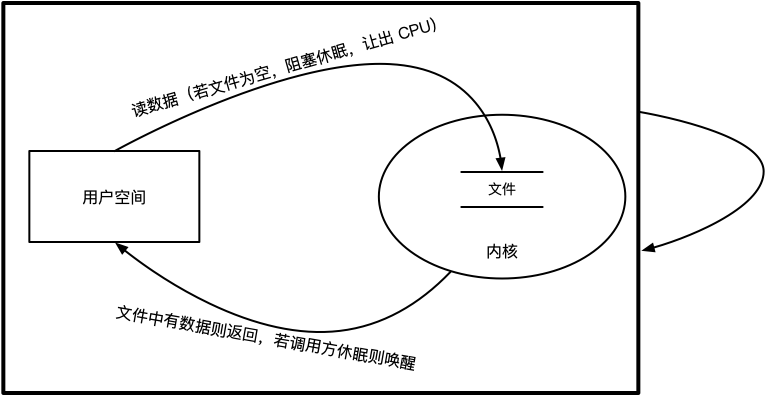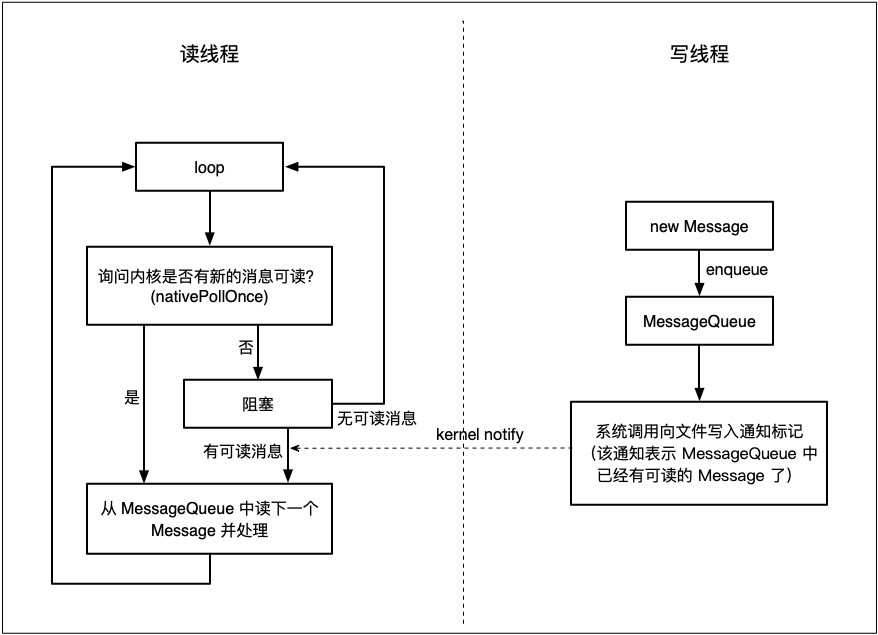我们知道,在 Android 中的大部分事件通知(比如 Activity 的生命周期通知)都是通过 Handler 机制来实现的。在 线程间通信模型——Handler 一文中曾提到:
消费者从共享队列中取消息,是通过 Handler 不停地访问消息队列来实现的。
也就是说,是 Handler 委托 Looper 轮询检查 MessageQueue 中是否有待处理的 Message。我们看一下 Looper.loop() 的关键代码:
public static void loop() {
// ...省略
final MessageQueue queue = me.mQueue;
// ...省略
for (;;) {
Message msg = queue.next(); // might block
if (msg == null) {
// No message indicates that the message queue is quitting.
return;
}
// ...省略
msg.target.dispatchMessage(msg);
// ...省略
msg.recycleUnchecked();
}
}我们看到,loop() 在一个死循环中不停地从消息队列中取下一个消息,看看是否有待处理的非空消息,如果没有,紧接着下次循环马上再去检查。咋一看,这样马不停蹄地轮询应该非常消耗 CPU 资源,给人的感觉是 CPU 一直被 UI 线程占用着(一般 loop() 运行在主线程中),应该会导致 ANR 才对。但是为什么我们没有看到这样的现象发生呢?
实际上,Looper.loop() 之所以没有引起 ANR,是因为其底层实现了阻塞IO事件通信,一个典型的阻塞IO通信模型如下图所示:
调用方(进程或线程)从用户空间通过系统调用读取内核中打开的一个文件,若文件中没有数据,则调用方让出 CPU 进入休眠,直到事件产生方写入事件到文件为止,这时内核唤醒调用方并返回通知事件。
可以看到,上述的过程即便在一个死循环当中也不会无休止地占用 CPU 资源。在操作系统原理进程生命周期管理中,我们知道当运行中的进程因为缺少资源时会挂起进入等待队列,从运行态进入阻塞态。所以调用方即便在死循环中通过系统调用访问空文件时,内核的进程管理会将其从运行态转变为阻塞态。
那么 Looper.loop() 是如何实现了阻塞 IO 的呢?在继续往下阅读之前,需要提前了解一下 阻塞IO和IO多路复用机制——select/poll/epoll、管道(pipe)原理、Linux eventfd。
继续第一节的 Looper.loop() 源代码,其关键在于下面这行代码:
Message msg = queue.next(); // might block注意后面的注释 might block(可能发生阻塞),所以秘密应该就隐藏在 MessageQueue.next() 方法中,我们继续看看:
Message next() {
// Return here if the message loop has already quit and been disposed.
// This can happen if the application tries to restart a looper after quit
// which is not supported.
final long ptr = mPtr;
if (ptr == 0) {
return null;
}
int pendingIdleHandlerCount = -1; // -1 only during first iteration
int nextPollTimeoutMillis = 0;
for (;;) {
if (nextPollTimeoutMillis != 0) {
Binder.flushPendingCommands();
}
// 底层实现:epoll IO 阻塞
nativePollOnce(ptr, nextPollTimeoutMillis);
synchronized (this) {
//...省略消息(Message)处理
//...省略 idle handler
}
//...省略
nextPollTimeoutMillis = 0;
}
}因为阻塞IO一定是在 native 层实现的,所以在 MessageQueue.next() 方法中我们只需要关注死循环中的一个本地方法——nativePollOnce()。该方法在 native 层通过 epoll 系统调用以阻塞的方式来向内核询问是否有新消息产生。
nativePollOnce() 的实现在 android_os_MessageQueue.cpp 中:
//...
static void android_os_MessageQueue_nativePollOnce(JNIEnv* env, jobject obj,
jlong ptr, jint timeoutMillis) {
NativeMessageQueue* nativeMessageQueue = reinterpret_cast<NativeMessageQueue*>(ptr);
nativeMessageQueue->pollOnce(env, obj, timeoutMillis);
}
//...
void NativeMessageQueue::pollOnce(JNIEnv* env, jobject pollObj, int timeoutMillis) {
mPollEnv = env;
mPollObj = pollObj;
mLooper->pollOnce(timeoutMillis);
mPollObj = NULL;
mPollEnv = NULL;
if (mExceptionObj) {
env->Throw(mExceptionObj);
env->DeleteLocalRef(mExceptionObj);
mExceptionObj = NULL;
}
}
//...从代码中可以看到,其核心实现在 Looper.cpp 中的 pollOnce() 方法中。需要注意的是,Android 5.0 及之前的版本与 Android 6.0 及以后的版本中,Looper.cpp 的实现有所不同。
在 ≤Android5.0 中,Looper.cpp 采用 epoll+pipe 来实现阻塞IO事件通知;在 ≥Android6.0 中,Looper.cpp 采用 epoll+eventfd 来实现阻塞IO事件通知。
- ≤Android5.0 Looper.cpp 关键代码
构造方法:
Looper::Looper(bool allowNonCallbacks) :
mAllowNonCallbacks(allowNonCallbacks), mSendingMessage(false),
mResponseIndex(0), mNextMessageUptime(LLONG_MAX) {
// 创建管道
int wakeFds[2];
int result = pipe(wakeFds);
//...省略
// 保存管道读端文件描述符(用于读线程)和写端文件描述符(用于写线程)
mWakeReadPipeFd = wakeFds[0];
mWakeWritePipeFd = wakeFds[1];
//...省略
// 创建 epoll 实例
mEpollFd = epoll_create(EPOLL_SIZE_HINT);
//...省略
// 初始化 epoll 请求事件
struct epoll_event eventItem;
memset(& eventItem, 0, sizeof(epoll_event)); // zero out unused members of data field union
eventItem.events = EPOLLIN; // 期待读数据
eventItem.data.fd = mWakeReadPipeFd; // epoll 监控管道读端
// 添加管道读端描述符和请求事件参数
result = epoll_ctl(mEpollFd, EPOLL_CTL_ADD, mWakeReadPipeFd, & eventItem);
//...省略
}Looper.pollOnce()
int Looper::pollOnce(int timeoutMillis, int* outFd, int* outEvents, void** outData) {
int result = 0;
for (;;) {
//...省略
result = pollInner(timeoutMillis);
}
}
int Looper::pollInner(int timeoutMillis) {
//...省略
// Poll.
int result = POLL_WAKE;
//...省略
// epoll 返回事件,用于指定稍后pipe中发生了什么事件
struct epoll_event eventItems[EPOLL_MAX_EVENTS];
// epoll_wait 系统调用,若 pipe 为空则阻塞,让出 CPU
int eventCount = epoll_wait(mEpollFd, eventItems, EPOLL_MAX_EVENTS, timeoutMillis);
//...省略
for (int i = 0; i < eventCount; i++) {
int fd = eventItems[i].data.fd;
uint32_t epollEvents = eventItems[i].events;
if (fd == mWakeReadPipeFd) {
if (epollEvents & EPOLLIN) { // 期待的可读事件发生
// 从 pipe 中读取发生的事件,该调用主要是确认管道是否真的能读到消息,如果能读到直接返回,java 层的 Looper.loop() 就知道 MessageQueue 中有 Message 可读了
awoken();
} else {
//...省略
}
} else {
//...省略
}
}
//...省略
return result;
}
void Looper::awoken() {
//...省略
char buffer[16];
ssize_t nRead;
do {
// 读取 pipe 中的字节流
nRead = read(mWakeReadPipeFd, buffer, sizeof(buffer));
} while ((nRead == -1 && errno == EINTR) || nRead == sizeof(buffer));
}Looper.wake()
void Looper::wake() {
//...省略
ssize_t nWrite;
do {
// 向 pipe 写端写入通知消息
nWrite = write(mWakeWritePipeFd, "W", 1);
} while (nWrite == -1 && errno == EINTR);
//...省略
}Looper.wake() 方法一般在 java 层的 Handler 往 MessageQueue 中插入新的 Message 后通过本地方法调用。这样内核马上就能知道 pipe 中有新的消息,Looper.pollOnce() 中的 epoll_wait 系统调用就可以解除阻塞得到返回。
MessageQueue.enqueueMessage()
boolean enqueueMessage(Message msg, long when) {
//...省略
synchronized (this) {
//...省略
msg.markInUse();
msg.when = when;
Message p = mMessages;
boolean needWake;
//...省略消息插入代码
// We can assume mPtr != 0 because mQuitting is false.
if (needWake) {
// 底层由 Looper.cpp 中的 wake() 方法实现,即直接想 pipe 写入端写通知事件
nativeWake(mPtr);
}
}
return true;
}android_os_MessageQueue.cpp
static void android_os_MessageQueue_nativeWake(JNIEnv* env, jclass clazz, jlong ptr) {
NativeMessageQueue* nativeMessageQueue = reinterpret_cast<NativeMessageQueue*>(ptr);
nativeMessageQueue->wake();
}
void NativeMessageQueue::wake() {
// Looper.cpp 中的 wake()
mLooper->wake();
}- ≥Android6.0 Looper.cpp 关键代码
构造方法:
Looper::Looper(bool allowNonCallbacks)
: mAllowNonCallbacks(allowNonCallbacks),
mSendingMessage(false),
mPolling(false),
mEpollRebuildRequired(false),
mNextRequestSeq(0),
mResponseIndex(0),
mNextMessageUptime(LLONG_MAX) {
// 构造 eventfd 计数器实例并保存 eventfd 文件描述符
// mWakeEventFd 是一个 android::base::unique_fd 对象,是一个文件描述符容器
mWakeEventFd.reset(eventfd(0, EFD_NONBLOCK | EFD_CLOEXEC));
//...省略
rebuildEpollLocked();
}
void Looper::rebuildEpollLocked() {
//...省略
// 创建 epoll 实例
// 和 mWakeEventFd 类似,mEpollFd 也是一个 android::base::unique_fd 类型的文件描述符容器
mEpollFd.reset(epoll_create1(EPOLL_CLOEXEC));
//...省略
// 初始化 epoll 请求事件
struct epoll_event eventItem;
memset(& eventItem, 0, sizeof(epoll_event));
eventItem.events = EPOLLIN; // 期待读数据
eventItem.data.fd = mWakeEventFd.get();
// 添加 eventfd 描述符和请求事件参数
int result = epoll_ctl(mEpollFd.get(), EPOLL_CTL_ADD, mWakeEventFd.get(), &eventItem);
//...省略
}Looper.pollOnce()
int Looper::pollOnce(int timeoutMillis, int* outFd, int* outEvents, void** outData) {
int result = 0;
for (;;) {
//...省略
result = pollInner(timeoutMillis);
}
}
int Looper::pollInner(int timeoutMillis) {
//...省略
// Poll.
int result = POLL_WAKE;
//...省略
// epoll 返回事件,用于指定稍后 eventfd 中发生了什么事件
struct epoll_event eventItems[EPOLL_MAX_EVENTS];
// epoll_wait 系统调用,若 eventfd 计数器为 0 则阻塞,让出 CPU
int eventCount = epoll_wait(mEpollFd.get(), eventItems, EPOLL_MAX_EVENTS, timeoutMillis);
//...省略
for (int i = 0; i < eventCount; i++) {
int fd = eventItems[i].data.fd;
uint32_t epollEvents = eventItems[i].events;
if (fd == mWakeEventFd.get()) {
if (epollEvents & EPOLLIN) { // 期待的可读事件发生
// 从 eventfd 中读取发生的事件,该调用主要是确认 eventfd 计数器是否真的能读到消息,如果能读到直接返回,java 层的 Looper.loop() 就知道 MessageQueue 中有 Message 可读了
awoken();
} else {
//...省略
}
} else {
//...省略
}
}
//...省略
return result;
}
void Looper::awoken() {
//...省略
uint64_t counter;
// 读取 eventfd 计数器的值
TEMP_FAILURE_RETRY(read(mWakeEventFd.get(), &counter, sizeof(uint64_t)));
}Looper.wake()
void Looper::wake() {
//...省略
uint64_t inc = 1;
// 向 eventfd 计数器写入一个无符号64位整型通知消息
ssize_t nWrite = TEMP_FAILURE_RETRY(write(mWakeEventFd.get(), &inc, sizeof(uint64_t)));
//...省略
}Looper.wake() 方法一般在 java 层的 Handler 往 MessageQueue 中插入新的 Message 后(MessageQueue.enqueueMessage() 方法)通过本地方法调用。这样内核马上就能知道 eventfd 计数器中有新的消息,Looper.pollOnce() 中的 epoll_wait 系统调用就可以解除阻塞得到返回。
MessageQueue.enqueueMessage() 方法的调用与 ≤Android5.0 中的一致,无须赘述。
抛开两个版本的实现细节,Looper 事件通知的总体流程可以抽象如下:
- 同一个进程内的线程间通信为什么选择 pipe/eventfd 这种跨进程通信方案?
原因是为了做到事件通知更及时。如果采用常规的线程间通信方法实现事件通知,则需要手动休眠线程,然后反复去轮询检查事件队列是否有新事件产生。但是这个休眠时间不好控制,设置短了浪费 CPU,设置长了,新事件半天得不到响应和处理。
而 select/poll/epoll + pipe/eventfd 这种跨进程通信方案的本质是让内核监控一个打开的文件的 IO 行为,通过注册事件、监听、阻塞、通知来实现的一套底层观察者模式。如果把 select/poll/epoll + pipe/eventfd 抽象成只是一个观察者模式,那么就不必限定其只能用于 IPC 了。
当然,也可以采用典型的观察者模式,通过线程间引用共享变量+锁实现同步的方案来实现事件通知(wait/notify方案)。但是这无疑引入了更多的耦合性,线程间无法做到很好的隔离,增加了实现的复杂性和出错的可能性。既然 Linux 内核已经提供了更简单更有效的通信方案,何必要重复造轮子呢?
- IO多路复用方案中为什么选择 epoll,而不用 select/poll?
在 IO多路复用——selct,poll,epoll 中我们总结 epoll 相对于 select/poll 的主要性能优势有两点:
- 在监控大量文件描述符的应用场景中,epoll 比 select/poll 有更大的时间复杂度优势(epoll 查询就绪文件描述符的时间复杂度是 O(1),而 select/poll 是 O(n))。
- epoll 系统调用比 select/poll 系统调用需要更少的内存拷贝次数(epoll 只需要在返回就绪文件描述符时从内核往用户空间拷贝一次;而 select/poll 需要在调用时从用户空间和内核空间进行两次拷贝)。
很显然,在 Looper 事件通知中,监控的文件描述符数量非常少(2个或者1个),所以第一条优势并不明显。所以,更少的内存拷贝次数应该是选择 epoll 的主要原因。
- 为什么 Android6.0 及以后的版本用 eventfd 替代 pipe 作为通信方案?
关于这一点,可以参考 跨进程通信之管道 和 跨进程通信之eventfd
总结来说,主要原因有两点:
- pipe 本质上是内核空间分配的一个字节流缓冲器,需要预先为期分配至少 4K 的内存空间,这对于简单的事件通知来说是一种空间浪费。而 eventfd 只是内核空间的一个 64位无符号整型计数器,相比 pipe 可以节省很大的内存空间。
- pipe 是单向的,读端和写端是分开的,各需要分配一个文件描述符,对于事件通知模型来说显得过重。且在创建管道的过程中需要通信双方各自关闭未使用的文件描述符,虽属必要,但使用复杂性过高,容易出错。而 eventfd 只需一个文件描述符(内核分配的文件描述符数量是有限的),且对 eventfd 的读操作就是直接清空计数器(如果没有设置信号量原语),操作非常简单高效,几乎就是为事件通知模型量身定做的方案。

